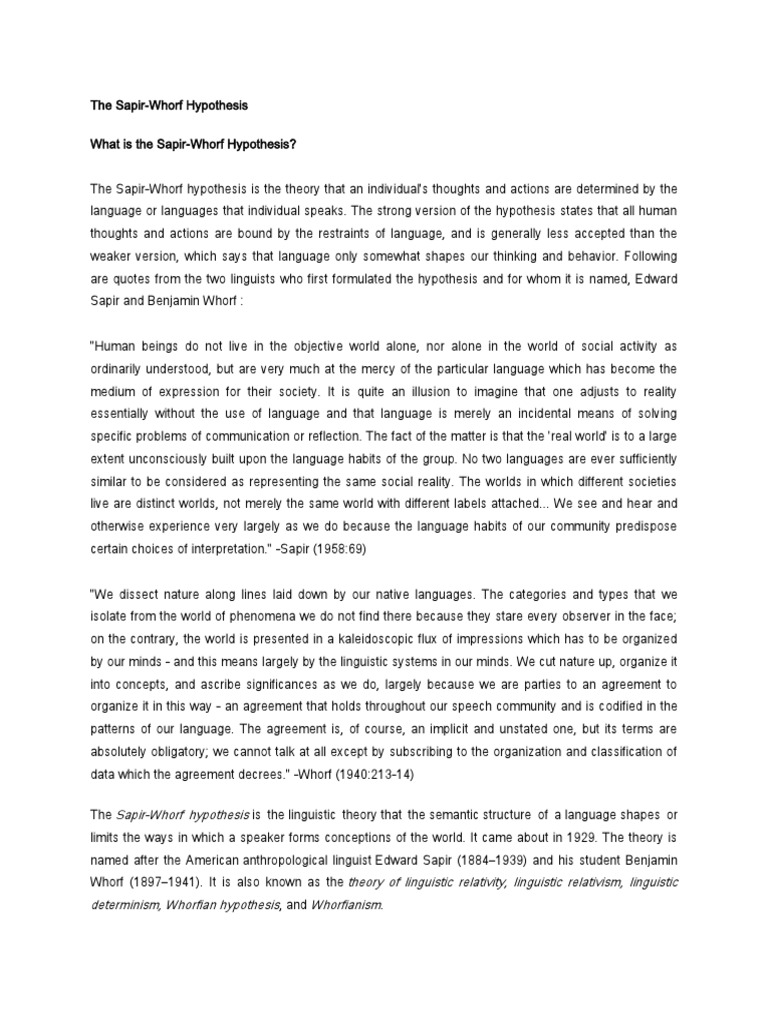The Whorf-Sapir hypothesis, more commonly referred to as the linguistic relativity hypothesis, posits that the structure of a language influences its speakers’ cognition and worldview. This captivating theory, stemming from the work of linguists Edward Sapir and Benjamin Lee Whorf, proposes that language is not merely a tool for communication but also shapes the very essence of our thoughts. This article delves into the intriguing intersection of the Whorf-Sapir hypothesis and the medium of comic art, exploring how this approach has the potential to convey complex linguistic theories in more accessible and engaging ways.
At its core, the Whorf-Sapir hypothesis highlights a common observation: language and thought are interwoven, intricately linked in a dance that reflects and influences cultural understanding. This notion raises deeper questions about how diverse linguistic structures can lead to distinct ways of perceiving reality. For instance, languages that have numerous words for “snow,” such as certain Inuit languages, may engender a more nuanced appreciation for winter’s meteorological variations compared to a language with only one word for snow. This variance illuminates cultural priorities and experiences that shape how individuals interact with their environment.
As we embark on the exploration of the Whorf-Sapir hypothesis through comics, it is essential to consider the unique qualities of the comic medium. Comics combine visual art with textual narrative, providing a dual-source input for conveying ideas. This multimodal approach allows for the simplification of complex theories, making them accessible to a broader audience. Through stark imagery and succinct captions, comics can illustrate abstract concepts, such as linguistic relativity, in an engaging and digestible manner.
In a comic format, the Whorf-Sapir hypothesis can be depicted through the interactions of characters who speak different languages. These characters might encounter situations where their language shapes their perception of a common event. For example, one character may perceive a grassy meadow through the lens of a language rich in botanical terms, marveling at the distinctions between various shades of green. In contrast, another character whose language lacks such specificity may simply reference “green grass.” This contrasting viewpoint crystalizes the notion that language profoundly affects cognitive subtleties.
Additionally, comic narratives offer the opportunity to portray the “Sapir-Whorf effect” in dynamic storytelling. Characters can embark on adventures that highlight the nuances of their linguistic frameworks. Illustrating a character’s struggle to communicate complex emotions due to inadequate vocabulary may foster empathy in readers who recognize their own experiences of linguistic limitation. Furthermore, incorporating humor into these scenarios can serve as a technique for engaging with the often dense theoretical aspects of linguistics, rendering complex ideas approachable and enjoyable.
Nevertheless, while creating a comic based on the Whorf-Sapir hypothesis, care must be taken not to oversimplify its implications. The theory has faced criticism and misinterpretation over the years, with some critics arguing that it implies a rigid determinism—that language wholly dictates thought. An effective comic should therefore strike an equilibrium, revealing the myriad ways language influences perception without suggesting a totalizing power. This nuanced representation can be accomplished by presenting multiple perspectives within the narrative, displaying how a spectrum of linguistic structures can coexist and interact.
Moreover, the comic medium can serve as an incubator for innovative thinking by encouraging readers to visualize the connections between language, thought, and culture. By demonstrating elements of cultural relativity through compelling imagery and storylines, comics have the capacity to challenge and provoke discussion around the limitations and potentialities of language. They may inspire readers to reconsider their assumptions about communication and cultural understanding or encourage them to engage with linguistics in a meaningful way.
In addition, the platform provided by comics can be invaluable for advancing conversations surrounding linguistic diversity and preservation. In today’s globally interconnected world, a multitude of languages face extinction. As communities grapple with the loss of linguistic heritage, the Whorf-Sapir hypothesis serves as a reminder of the rich cognitive diversity that languages encapsulate. Illustrated narratives can catalyze awareness of endangered languages and their unique worldviews, fostering appreciation for the languages that continue to exist and thrive.
Furthermore, comics themselves reflect linguistic and cultural relativity, often borrowing elements from various genres and traditions. This hybrid nature allows artists to play with language and style, mirroring the central tenets of the Whorf-Sapir hypothesis. As readers engage with comics that employ diverse languages, dialects, and visual aesthetic choices, they are prompted to reflect on their cognitive frameworks and the influences that shape them.
Ultimately, the intersection of the Whorf-Sapir hypothesis and comics opens up an expansive terrain for exploration. By marrying linguistic theory with visual storytelling, comics can illuminate the ways language frames our perceptions of the world, all while engaging a varied audience. Such narratives can serve not only as entertainment but also as a medium for philosophical inquiry, fostering a greater understanding of our linguistic and cultural diversity. As engagement with the Whorf-Sapir hypothesis continues to evolve, the potential for comics to delineate complex ideas will remain a vibrant and significant endeavor.
